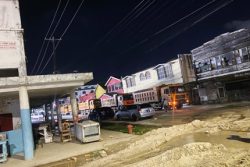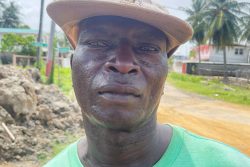Residents of Coverden on the East Bank Demerara on Thursday restated strong objections to the proposed storage of radioactive Industrial X-Ray and Gamma Ray Equipment at a facility in their community and are demanding that an impact assessment be conducted in keeping with international standards.
Non Destructive Testers Limited (NDTL), a Trinidadian-based company, has partnered with National Hardware to undertake the venture. The storage facility will be located at 1-2 Coverden, East Bank Demerara.
The Environmental Protection Agency (EPA) had said that the proposed operation would not require an impact assessment. Instead NDTL would have to prepare an Environmental Management Plan (EMP).
This decision was opposed by Coverden residents, leading to an appeal hearing on Thursday before the Environmental Assessment Board (EAB). The public hearing was held at Duke Lodge, Kingston. A decision will now have to be handed down by the EAB.
A primary concern of the appellants is the possible health risks that may result from radiation exposure.
“The developer presents the best-case scenario, I am concerned with the worst-case scenario,” appellant Dr Stacy Wilson-James told members of the EAB. She noted that numerous diseases can stem from radiation exposure that are not reversible and would be life impacting.
If there was a leakage from the facility, it would take six months before residents would know if they were exposed as the company would only be conducting biannual checks for potential leaks, she said.
Unconvinced by assurances that residents will not be affected by NDTL’s operation, Wilson-James noted that as part of its safety procedure, the badges of employees must be tested every month. She added that they are basically testing whether an employee was exposed to radiation without having to alarm them and may not tell them if it was so. She concluded that this can only mean that NDTL is only interested in protecting themselves and their operation.
She pointed out that NDTL has outlined lines of communication in the event there is an accident or contamination but residents of Coverden are not included in the communication chains. “When will we be informed that we have been exposed to radiation?” she asked.
“EPA please live up to your name: protect the environment,” Wilson-James added.
Citing a case in Ecuador involving Chevron where the oil giant refused to compensate local communities and Indigenous Peoples for decades of the disposal of harmful chemicals into rivers that have left them suffering from illnesses related to radiation exposure, Wilson-James made known her lack of faith in NDTL.
“What happens if there is contamination? Will the company be held accountable for damages? Radioactive exposure has a lifelong impact. What are you going to say, sorry?” she asked.
She added: “I do not object to establishing businesses in Coverden. This company plans to handle dangerous material in a residential area.”
“Why Coverden?” asked another appellant. She argued that the type of material being stored in the facility will make Coverden a sensitive security area.
Tourism hotspot
It was said that NDTL proposed to store the equipment in the area because residents were not undertaking any business venture in the area. However, the appellant said, NDTL could not have known this because they did not engage the community before seeking an environmental permit. In fact, she says, if an Environmental and Social Impact Assessment (ESIA) was done, they would have known that there is a plan to transform Coverden into a tourism hotspot. Should the EPA proceed in approving an environment permit, she said, the plan is likely to fall apart because no one would want to visit an area where there is risk of radiation exposure.
Penelope Howell, another appellant in the case, questioned why the EPA is opposed to conducting an impact assessment even though from the very beginning – as this is not the first hearing related to the project – residents have not been in favour of it.
Howell says the location where NDTL intends to conduct its operation is where “ordinary people conduct ordinary activities.” She notes that there is a drain near the facility where children play and brought to the fore the issue of disposal.
Before an environmental permit is approved, she argued, details of daily activities surrounding the area should be known, while stressing the importance of an impact assessment.
Although NDTL say they would not be using the Demerara River to transport the materials to clients, Howell says they are not convinced, saying that the location was chosen for a purpose. However, NDTL said that transporting the equipment via water was a consideration, but this would not happen in the foreseeable future due to country laws.
For its part, the EPA said their screening tools determined that the risk of exposure to radioactive material stored in the facility by residents is low. If there were a fire, the EPA representative said, anyone within a 100-meter radius would be exposed but there are no residents within this vicinity. The nearest resident is 200 meters away.
The representative said that based on NDTL’s response plan, EPA is confident that the company can handle any worst-case scenarios. As it relates to transporting the materials from the facility, there is very low risk. While there will be emissions during transport, it will not have significant impact.
The EPA says that no effluent will be discharged to the local drain with the potential to run off into the Demerara River and concludes that the risk from use and transport of those radioactive materials is low and reversible.
Concerns were also raised on the EPA’s experience in issuing a permit for this type of material. The EPA says this would be the first permit to be issued for industrial radiography but it would’ve issued similar types before.
On the other hand, NDTL contended that there is no requirement for community involvement in their operation because there is no danger or risk of exposure.
Both NDTL and the EPA in their presentations on Thursday stressed that the facility in Coverden will only be used for storage. Despite this, the EPA said, permits will be issued for storage, use, and transport – a statement that came under question by EAB Chair Pradeepa Bholanath, who asked why that is the case when it clearly stated otherwise in the Project Summary.
While welding and fabrication form part of the proposed project, the NDTL representative stated that they did not apply for a permit to conduct those operations. Bholanath advised that NDTL inform the Neighbourhood Democratic Council (NDC) and let them know that the permit is only for storage and have it adjusted.
It is unclear why the EPA will be issuing a permit for use but Bholanath noted that if a permit for use is to be issued, then the risks associated with it must be comprehensively assessed.
Appellants are requesting that an impact assessment be done in keeping with international standards considering the toxicity of the materials that are to be stored at the facility and that both National Hardware and NDTL be held accountable for any negative impact that their operation in Coverden may have.







